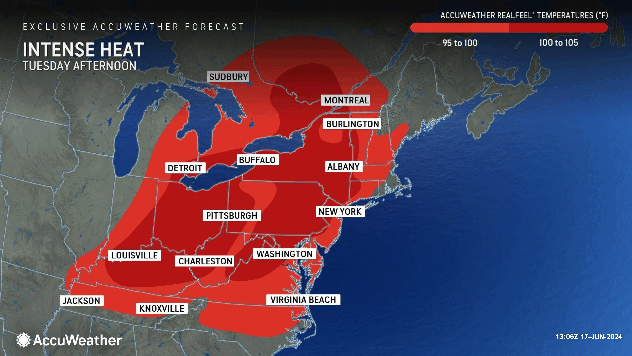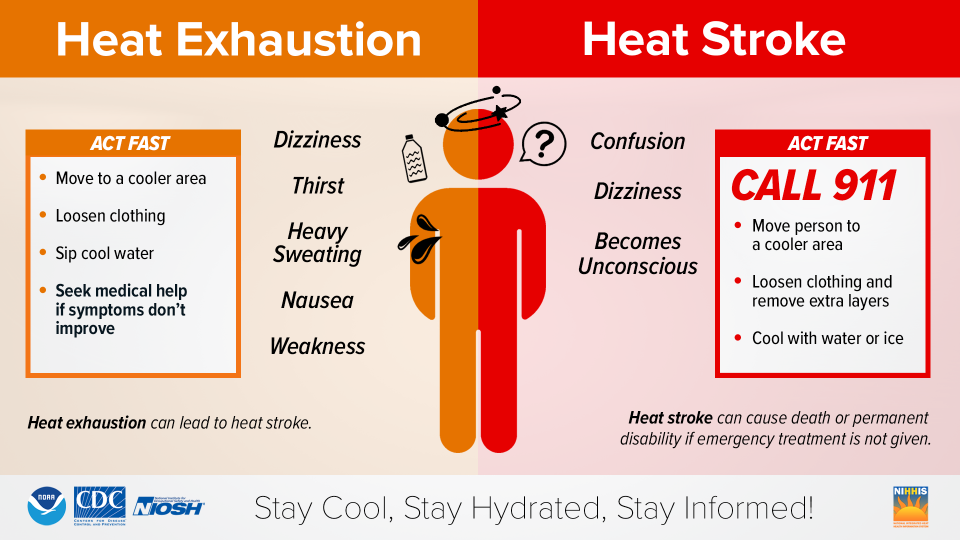Heat dome? Heat wave? How hot is it getting? Here's what you should know
Temperatures across New England are expected to be the hottest in years, with temperatures are expected to climb into the mid-90s in Providence and with some parts of Massachusetts possibly getting into the 100s.
Heat advisories are in effect nearly all of New England, with the National Weather Service predicting near to record breaking temperatures. The only exception is along the coastal areas, where the ocean will keep temperature in the slightly more reasonable 80s.
"There won't be much relief," Torry Dooley, a meteorologist from the National Weather Service in Norton, said Monday. "This is going to be a prolonged stretch of heat."
The National Weather Service forecast calls for the heat to peak on Thursday and the temperatures to turn more seasonable heading into the weekend.
But in the meantime, here's what you should know about the heat and what's coming.
Heat wave driving up temperatures in US Midwest, Northeast

It's not just the New England states that are going through the heat wave.
For many in the Midwest and Northeast, this week will be the first official heat wave of the season, which, in this part of the country is defined as three or more consecutive days of at least 90-degree temperatures, according to AccuWeather.
Heat alerts have been issued for more than a dozen states, stretching from Iowa and Illinois to Maine.
See weather-related watches, warnings, advisories across New England, US
Forecast high temperatures across the US Midwest, Northeast
High temperatures expected for several Midwest and Northeast cities Juneteenth and June 20. Watch as temperatures drop between this week and early next week:
Providence, 92 on Thursday, dropping to 82 by June 24
Manchester, New Hampshire: 97, 99. Dropping to 86 by June 24.
Caribou, Maine: 96, 95. Dropping to 76 by June 24.
Boston, Massachusetts: 95, 97. Dropping to 85 by June 24.
Setting your a/c thermostat: Florida high heat index: What's the best temperature to set your air conditioner thermostat?
What is a 'heat dome'?
The phrase "heat dome" really isn't a scientific term, according to Jessie Schaper, meteorologist with the National Weather Service Melbourne.
Where confusion comes may be what's happening in the atmosphere.
"Under high pressure, the air subsides — sinks — toward the surface. This sinking air acts as a dome capping the atmosphere, NOAA said.
"This cap helps to trap heat instead of allowing it to lift. Without lift, there is little or no convection and, therefore, little or no convective clouds — cumulus clouds — with minimal chances for rain. The end result is a continual build-up of heat at the surface that we experience as a heat wave."
A heat wave is a period of abnormally hot weather generally lasting more than two days, according to the National Weather Service.
What is a heat advisory?
A heat advisory is one of several types of health alerts issued by the National Weather Service. A heat advisory is issued within 12 hours of the onset of extremely dangerous heat conditions.
The National Weather Service Boston issues a heat advisory when the heat index value is expect to exceed 97. An excessive heat watch is issued when a heat index value up to 105 degrees is possible.
If a heat advisory is issued, take precautions to avoid heat illness. If you don't take precautions, you may become seriously ill or even die.
What types of heat warnings does NWS issue?
The National Weather Service issues several types of heat-related advisories, including:
Excessive heat warning: An excessive heat warning is issued within 12 hours of the onset of extremely dangerous heat conditions. If you don't take precautions immediately when conditions are extreme, you may become seriously ill or even die.
Excessive heat watch: Heat watches are issued when conditions are favorable for an excessive heat event in the next 24 to 72 hours. A watch is used when the risk of a heat wave has increased but its occurrence and timing is still uncertain.
Excessive heat outlooks: The outlooks are issued when the potential exists for an excessive heat event in the next three to seven days. An outlook provides information to those who need considerable time to prepare for the event.
Heat stroke vs heat exhaustion: How to tell the difference

When your body can't cool itself, your body temperature rises. If it goes too high, it can be life-threatening.
The Centers for Disease Control and Prevention provided a list of warning signs and symptoms of heat-related illnessesand what you should do.
Heat cramps
Heat cramps may be the first sign of heat-related illness, and may lead to heat exhaustion or stroke.
Symptoms: Painful muscle cramps and spasms usually in legs and abdomen and heavy sweating.
First aid: Apply firm pressure on cramping muscles or gently massage to relieve spasm. Give sips of water unless the person complains of nausea, then stop giving water.
Seek immediate medical attention if cramps last longer than 1 hour.
Heat exhaustion
Symptoms: Heavy sweating, Weakness or tiredness, cool, pale, clammy skin; fast, weak pulse, muscle cramps, dizziness, nausea or vomiting, headache, fainting,
First aid: Move person to a cooler environment, preferably a well-air-conditioned room. Loosen clothing. Apply cool, wet cloths or have person sit in a cool bath. Offer sips of water. If person vomits more than once seek immediate medical attention if the person vomits, symptoms worsen or last longer than 1 hour.
Symptoms: Throbbing headache, confusion, nausea, dizziness, body temperature above 103°F, hot, red, dry or damp skin, rapid and strong pulse, fainting, loss of consciousness.
First Aid: Call 911 or get the victim to a hospital immediately. Heat stroke is a severe medical emergency. Delay can be fatal.
Move the victim to a cooler, preferably air-conditioned, environment. Reduce body temperature with cool cloths or bath. Use fan if heat index temperatures are below the high 90s. A fan can make you hotter at higher temperatures.
Do not give fluids.
This article originally appeared on Treasure Coast Newspapers: Record high temps possible in New England: Heat wave, heat dome ahead

